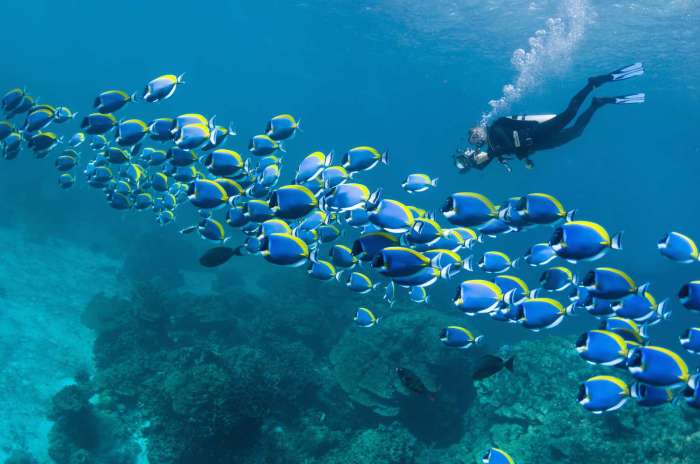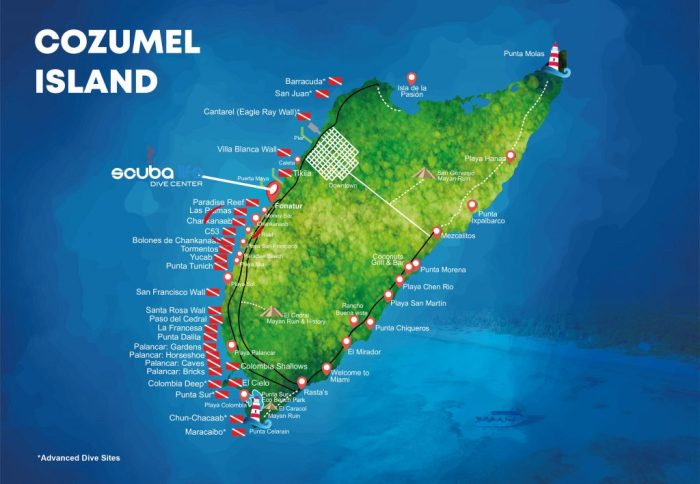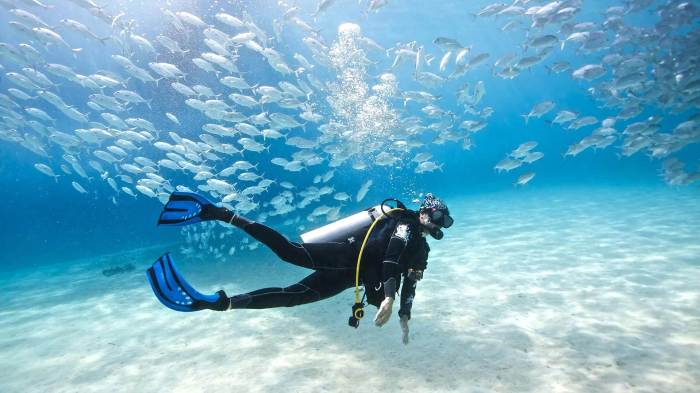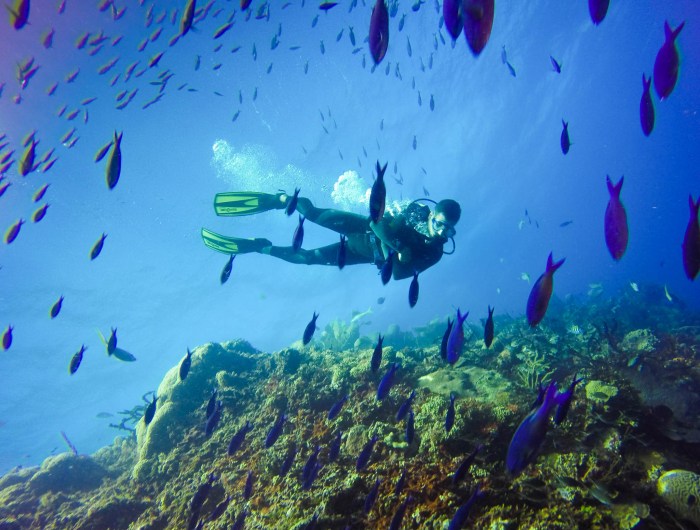Immerse yourself in the captivating realm of scuba diving locations, where vibrant marine life, crystal-clear waters, and awe-inspiring underwater landscapes await. From the tropical reefs of the Caribbean to the enigmatic depths of the Pacific, embark on an unforgettable journey to explore the most renowned and highly-rated scuba diving destinations.
Each location offers unique features, from diverse marine ecosystems to thrilling diving conditions. Whether you’re a seasoned diver or a novice seeking an extraordinary adventure, this guide will provide all the essential information to plan your next underwater escapade.
Scuba Diving Locations
Scuba diving offers an unparalleled opportunity to explore the wonders of the underwater world. From vibrant coral reefs teeming with marine life to mysterious shipwrecks and underwater caves, there are countless scuba diving locations around the world that offer unforgettable experiences.
The best scuba diving destinations vary depending on your interests and experience level. Some of the most popular and highly-rated locations include:
Great Barrier Reef, Australia
- Location: Coral Sea, off the coast of Queensland, Australia
- Region: Asia-Pacific
- Visibility: 10-30 meters (33-98 feet)
- Water Temperature: 22-29°C (72-84°F)
- Recommended Dive Sites: The Great Barrier Reef is home to over 2,900 individual reefs and 900 islands, offering a wide variety of dive sites for all levels of experience.
Cozumel, Mexico
- Location: Caribbean Sea, off the coast of the Yucatán Peninsula, Mexico
- Region: North America
- Visibility: 20-30 meters (66-98 feet)
- Water Temperature: 25-29°C (77-84°F)
- Recommended Dive Sites: Cozumel is known for its dramatic underwater walls, such as Palancar Reef and Santa Rosa Wall, as well as its abundant marine life, including sea turtles, rays, and sharks.
Galapagos Islands, Ecuador
- Location: Pacific Ocean, about 1,000 kilometers (620 miles) west of mainland Ecuador
- Region: South America
- Visibility: 10-20 meters (33-66 feet)
- Water Temperature: 18-24°C (64-75°F)
- Recommended Dive Sites: The Galapagos Islands are renowned for their unique marine life, including sea lions, penguins, and marine iguanas. Divers can also explore underwater lava formations and swim with hammerhead sharks.
Raja Ampat, Indonesia
- Location: West Papua, Indonesia
- Region: Asia-Pacific
- Visibility: 15-25 meters (49-82 feet)
- Water Temperature: 27-30°C (81-86°F)
- Recommended Dive Sites: Raja Ampat is home to some of the most biodiverse coral reefs in the world, with over 1,500 species of fish and 500 species of coral. Divers can also explore underwater caves and swim with manta rays.
Maldives
- Location: Indian Ocean, southwest of Sri Lanka
- Region: Asia-Pacific
- Visibility: 15-30 meters (49-98 feet)
- Water Temperature: 27-30°C (81-86°F)
- Recommended Dive Sites: The Maldives is known for its crystal-clear waters, white-sand beaches, and luxurious resorts. Divers can explore coral reefs, swim with whale sharks, and explore underwater shipwrecks.
Scuba Diving Safety and Considerations

Scuba diving is an exhilarating activity that allows you to explore the underwater world. However, it’s crucial to prioritize safety and take precautions to ensure a safe and enjoyable experience.
Scuba diving locations are aplenty, each offering unique experiences. Whether you’re a seasoned diver or a beginner, it’s crucial to plan your itinerary meticulously. A travel itinerary template can prove invaluable in organizing your diving schedule, ensuring you make the most of your underwater adventures.
From the vibrant coral reefs of the Caribbean to the enigmatic shipwrecks of the Mediterranean, meticulously plan your scuba diving itinerary to maximize your experience.
Obtaining proper scuba diving certifications and training from recognized organizations is essential. These certifications provide comprehensive knowledge and skills, including emergency procedures, equipment handling, and dive planning. They empower divers with the necessary competence and confidence to navigate underwater environments.
Potential Risks and Challenges
Scuba diving involves inherent risks and challenges that divers must be aware of. These include:
- Decompression sickness (DCS): Failure to ascend gradually can lead to DCS, where nitrogen bubbles form in the bloodstream, causing joint pain, dizziness, and more severe symptoms.
- Nitrogen narcosis: At depths greater than 100 feet, nitrogen can have intoxicating effects, impairing judgment and coordination.
- Equipment failure: Malfunctioning equipment, such as regulators or buoyancy compensators, can lead to emergencies.
- Environmental hazards: Strong currents, poor visibility, and marine life can pose challenges and require careful navigation.
Tips for a Safe and Enjoyable Diving Experience
To ensure a safe and enjoyable diving experience, consider the following tips:
- Plan your dives thoroughly, considering factors like depth, visibility, and currents.
- Dive with a buddy and stay within the limits of your training and experience.
- Use properly maintained and fitted equipment.
- Ascend gradually to avoid decompression sickness.
- Be aware of your surroundings and potential hazards.
- Respect marine life and avoid touching or harassing animals.
Types of Scuba Diving
Scuba diving encompasses various types, each tailored to specific interests and skill levels. These include recreational, technical, and cave diving, which differ in their unique requirements, equipment, and training.
Recreational Diving
Recreational diving is the most common type, intended for leisure and enjoyment. It typically takes place in shallow waters (less than 40 meters) and involves exploring coral reefs, shipwrecks, and marine life. Recreational divers use basic scuba gear, including a single tank, buoyancy compensator device (BCD), and mask. Popular dive sites for recreational diving include the Great Barrier Reef in Australia, the Red Sea in Egypt, and the Caribbean Sea.
Technical Diving
Technical diving involves exploring deeper waters (beyond 40 meters) and requires specialized equipment and training. Technical divers use multiple tanks, rebreathers, and advanced navigation systems to manage decompression and gas mixtures. This type of diving is suitable for experienced divers seeking more challenging and technical environments. Popular technical dive sites include the Blue Hole in Belize, the SS Thistlegorm in the Red Sea, and the wrecks of the Titanic and Bismarck.
Cave Diving
Cave diving is an extreme form of scuba diving that involves exploring underwater caves and caverns. It requires specialized training, equipment, and skills to navigate the confined and often dark environments. Cave divers use lights, guide lines, and redundant breathing systems to ensure safety. Popular cave diving sites include the Sistema Sac Actun in Mexico, the Cenotes of the Yucatan Peninsula, and the caves of the Galapagos Islands.
Scuba Diving Equipment and Gear

Scuba diving requires specialized equipment to ensure the safety and comfort of divers underwater. This equipment includes essential gear such as regulators, buoyancy compensators, and dive computers, as well as protective suits like wetsuits and dry suits.
Regulators
Regulators are devices that control the flow of compressed air from the scuba tank to the diver’s mouth. They reduce the high pressure of the air in the tank to a pressure that is safe for breathing underwater.
Scuba diving enthusiasts can explore the world’s most captivating underwater destinations, from the vibrant coral reefs of the Great Barrier Reef to the enigmatic shipwrecks of the Mediterranean Sea. However, planning a scuba diving trip can be daunting, especially when it comes to budgeting.
To simplify this process, consider using a travel budget calculator. This tool will help you estimate the costs associated with your diving adventure, ensuring you can plan a memorable and financially sound trip to explore the wonders of the underwater world.
- First Stage Regulator: Attaches to the scuba tank and reduces the pressure of the air.
- Second Stage Regulator: Delivers the air to the diver’s mouth and regulates the flow rate.
Buoyancy Compensators
Buoyancy compensators (BCDs) are inflatable vests that help divers control their buoyancy underwater. They allow divers to adjust their buoyancy to maintain a neutral position in the water.
- Jacket Style BCD: Provides full coverage and is suitable for beginners and recreational divers.
- Wing Style BCD: More streamlined and offers better buoyancy control for experienced divers.
Dive Computers, Scuba diving locations
Dive computers are electronic devices that provide divers with essential information such as depth, time, and air pressure. They help divers monitor their dives and avoid decompression sickness.
- Basic Dive Computers: Display depth, time, and air pressure.
- Advanced Dive Computers: Include additional features such as gas integration, decompression calculations, and wireless connectivity.
Wetsuits and Dry Suits
Wetsuits and dry suits are protective suits that divers wear to protect themselves from cold water and other underwater hazards.
- Wetsuits: Made of neoprene, a synthetic rubber that insulates the body by trapping water between the suit and the diver’s skin.
- Dry Suits: Made of waterproof materials, they keep the diver completely dry and are suitable for cold or contaminated water.
Marine Life Encounters

Scuba diving offers an unparalleled opportunity to encounter a diverse array of marine life, from the tiniest invertebrates to majestic sea creatures. These encounters can be both awe-inspiring and humbling, fostering a deep appreciation for the intricate balance of marine ecosystems.
It is crucial to approach these encounters with respect and care, adhering to best practices for preserving the delicate underwater environment. This includes avoiding touching or harassing marine life, respecting their natural habitats, and adhering to local regulations and guidelines.
From the depths of the ocean to the vibrant streets of far-off lands, adventure awaits! If you’ve explored the mesmerizing scuba diving locations, why not immerse yourself in the rich tapestry of cultures worldwide? Check out the best cultural festivals worldwide and plan your next escapade to witness the kaleidoscope of colors, rhythms, and traditions that celebrate the human spirit.
As you return to the serene underwater realm, you’ll carry with you the memories of cultural experiences that will enrich your soul.
Common Marine Species and Their Habitats
- Coral Reefs: Vibrant and teeming with life, coral reefs are home to a wide variety of species, including colorful reef fish, sea turtles, and sharks.
- Kelp Forests: These underwater forests provide shelter and food for a diverse range of marine organisms, including sea otters, seals, and various fish species.
- Sandy Beaches: Sandy beaches are important habitats for sea turtles, shorebirds, and a variety of burrowing creatures like crabs and clams.
- Open Ocean: The vast expanse of the open ocean is home to pelagic species such as dolphins, whales, and tuna, as well as seabirds and sea turtles.
Tips for Observing Marine Life Respectfully
- Maintain a safe distance and avoid touching or harassing marine life.
- Use underwater cameras to capture memories without disturbing the animals.
- Stay on designated dive trails and avoid damaging coral or other sensitive habitats.
- Respect local regulations and guidelines, such as restrictions on feeding or collecting marine life.
Underwater Photography and Videography

Underwater photography and videography present unique challenges and opportunities for capturing stunning images and videos beneath the surface. With the right techniques and equipment, divers can capture breathtaking scenes of marine life, coral reefs, and underwater landscapes.
Techniques for Underwater Photography
– Composition: Apply basic photography principles to underwater shots, considering elements like rule of thirds, leading lines, and negative space.
– Lighting: Utilize natural light or artificial lighting to compensate for underwater light absorption. Use strobes or LED lights to enhance colors and reduce backscatter.
– Focus: Manually adjust focus for sharp images, especially for close-up shots or subjects in motion.
– Exposure: Set appropriate shutter speed, aperture, and ISO settings to achieve optimal exposure and minimize blur.
Equipment for Underwater Photography and Videography
– Camera: Choose a camera suitable for underwater use, such as a compact camera with an underwater housing or a dedicated underwater camera.
– Lens: Select lenses with wide angles or fisheye lenses for capturing wide underwater scenes.
– Lighting: Use strobes or LED lights to illuminate subjects and reduce backscatter.
– Filters: Employ filters to adjust color balance and contrast underwater, such as red filters for blue water environments.
Challenges of Underwater Photography
– Limited Visibility: Underwater visibility can be affected by factors like water clarity, depth, and particles in the water.
– Lighting: Light is absorbed and scattered underwater, making it challenging to achieve proper exposure and reduce backscatter.
– Motion: Underwater subjects can move quickly, requiring fast shutter speeds and steady camera handling.
Tips for Editing and Sharing Underwater Images and Videos
– Post-Processing: Enhance images and videos using software to adjust colors, contrast, and exposure. Remove backscatter or unwanted objects.
– Sharing: Share images and videos on social media or online platforms, using relevant hashtags and descriptions to reach a wider audience.
– Conservation: Use underwater photography and videography to raise awareness about marine conservation and environmental issues.
Final Conclusion: Scuba Diving Locations
As you conclude your exploration of scuba diving locations, may this guide serve as a constant companion, inspiring you to seek out new adventures and marvel at the wonders of the underwater world. Remember, safety should always be paramount, and by embracing responsible diving practices, you can help preserve these fragile ecosystems for generations to come.
Frequently Asked Questions
What are the most popular scuba diving destinations?
The Maldives, Great Barrier Reef, Galapagos Islands, Red Sea, and Caribbean Sea are among the most sought-after scuba diving destinations.
What factors should I consider when choosing a scuba diving location?
Consider factors such as marine life diversity, visibility, water temperature, diving conditions, and available dive sites.
What are the essential scuba diving safety precautions?
Always dive with a certified buddy, obtain proper training and certification, respect marine life, and follow established diving guidelines.